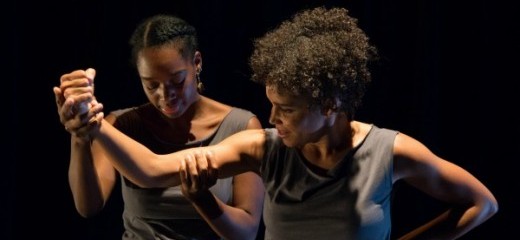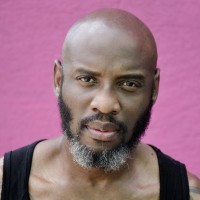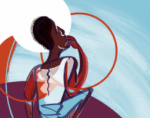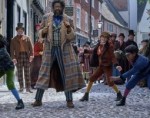
The Requisite Movers: The Complexities of Black Consciousness
by Gregory King
On the website newworldencyclopedia.org, writer John Conrad depicts African dance as “an expression of both savagery and aggressiveness.” He adds that European explorers of Africa understood very little of the aesthetics or meaning of dances in the culture they sought to scrutinize or conquer.The Nae-Nae, krumping, twerking, wining, and the Harlem shake are contemporary forms of diasporic dances that carry with them a potency that projects fear, sadness, joy, resilience, strength, vulnerability, and hope. In an essay titled “Commonalities in African Dance: An Aesthetic Foundation,” by dance scholar Kariamu Welsh, she explains some characteristics of dances in the African diaspora, calling attention to “the foot-stomping dance of the Muchongoyo of eastern Zimbabwe, the 6/8 rhythms of the samba from Brazil, the rumba of Cuba, the ring shout dances of the Carolinas and the jazz dance of Black America.” Through this elucidation, Welsh affirms that the complexities that arise from critiquing dances in the African Diaspora cannot be subjected to an oversimplification and the dances cannot be debased as sexual and primitive.
In an attempt to normalize non-European aesthetics by shifting the conversation to include the voices of socially conscious people of color, co-directors Lela Aisha Jones and Deneane Richburg created The Requisite Movers (TRM). With an artistic process that includes research, dialogue, and performance, the women of TRM tighten the nuts on complex social issues by engaging in critical feedback sessions with each other and their artistic mentors, Dr. Kariamu Welsh, Nia Eubanks Dixon, Marjani Forte-Saunders, Nia Love, and Germaine Ingram. What evolves from these sessions are multifaceted works that explore the black experience.
Southern Breeze, choreographed by Shana El, opened with dancer Oiya Lowe in a sit-bone balance, lifted but planted—her coccyx as root. She shifted her head to the left, lowering it to the floor, reminiscent of the Jesus figure in Michelangelo’s Pietà. Referential without literal narrative, Southern Breeze used Nina Simone’s recording of “Strange Fruit” to make a social commentary on police brutality against people of African descent. Wearing a dress the color of blood, Shana El joined Lowe on stage and, watching El waft through the space, her tortured body reflecting the bitter pain of the lyrics, Simone’s voice punctured me:
Southern trees bear strange fruit, blood on the leaves and blood at the root / Black bodies swinging in the southern breeze
El wasn’t dancing for herself.
In a hinged position she dangled her arms—breathing as they swayed, living in their lifelessness. Southern Breeze was a memory, an awareness, and a prophecy.
An oversized white umbrella was the main prop in Saroya Corbett’s Unprotected Characteristics. The umbrella, seemingly an abstract representation of whiteness sheltering blackness, was carried by Corbett’s dance partner Oiya Lowe, as she slowly moved towards the seated Corbett, who wore a black dress and a white pearl necklace. The image of Lowe’s shadow displayed on the walls of stage right and stage left made me think of the many stories we carry with us: the ones we choose to reveal and those concealed—two blackened forms living their own black stories.
Native Portals: Release Mourning Clearing was shown as a work in progress. Choreographed by Lela Aisha Jones, the work, according to the program notes, was an excerpt that would "delve into historical experiences of lynching, and would deepen our understanding of reconciliation and healing,” but I’m not sure if the excerpt adequately achieved her objective. The four women in Portals moved in unison with a rhythmic chant when they stamped. Their arms akimbo, they reminded me of my mother’s stance just before she would unleash her wrath, based on my wrongdoings. In a solo moment, Jones used her fingers to encircle her breasts before pointing towards her pubic bone. She placed her head in her hands and sighed, emitting an air of anguish supported by grief. But it wasn’t sorrow from surrender, it was a release, awaiting rebirth; and in that moment of rebirth, I assumed the healing would begin. I’ve always had issues with excerpts and works in progress because I am forced to enter the work with an understanding that there is no resolve, that what I’m asked to eat is a meal still being cooked. Portals was no exception.
Knowing that, through our blackness, we are connected to a shared history, I questioned what my experience would have been had there been a male voice—a dancer, a choreographer—in the show. Engaging, poignant and deeply moving, the choreographers of TRM have begun to revel in their artistic activism, using music, dance, and text to share their honesty without inhibitions.
The Requisite Movers, Lela Aisha Jones, Southern Breeze, Unprotected Characteristics, Native Portals: Release Mourning Clearing, Community Education Center, November 14-15
By Gregory King
November 20, 2015





.png)


